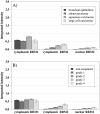Ribonucleotide reductase subunit M2 predicts survival in subgroups of patients with non-small cell lung carcinoma: effects of gender and smoking status
- PMID: 26001082
- PMCID: PMC4441434
- DOI: 10.1371/journal.pone.0127600
Ribonucleotide reductase subunit M2 predicts survival in subgroups of patients with non-small cell lung carcinoma: effects of gender and smoking status
Abstract
Background: Ribonucleotide reductase catalyzes the conversion of ribonucleotide diphosphates to deoxyribonucleotide diphosphates. The functional enzyme consists of two subunits - one large (RRM1) and one small (RRM2 or RRM2b) subunit. Expression levels of each subunit have been implicated in prognostic outcomes in several different types of cancers.
Experimental design: Immunohistochemistry for RRM1 and RRM2 was performed on a lung cancer tissue microarray (TMA) and analyzed. 326 patients from the microarray were included in this study.
Results: In non-small cell lung cancer (NSCLC), RRM2 expression was strongly predictive of disease-specific survival in women, non-smokers and former smokers who had quit at least 10 years prior to being diagnosed with lung cancer. Higher expression was associated with worse survival. This was not the case for men, current smokers and those who had stopped smoking for shorter periods of time. RRM1 was not predictive of survival outcomes in any subset of the patient group.
Conclusion: RRM2, but not RRM1, is a useful predictor of survival outcome in certain subsets of NSCLC patients.
Conflict of interest statement
Figures






Similar articles
-
Expression of Ribonucleotide Reductase Subunit-2 and Thymidylate Synthase Correlates with Poor Prognosis in Patients with Resected Stages I-III Non-Small Cell Lung Cancer.Dis Markers. 2015;2015:302649. doi: 10.1155/2015/302649. Epub 2015 Nov 17. Dis Markers. 2015. PMID: 26663950 Free PMC article.
-
Excision repair cross-complementing gene-1, ribonucleotide reductase subunit M1, ribonucleotide reductase subunit M2, and human equilibrative nucleoside transporter-1 expression and prognostic value in biliary tract malignancy.Cancer. 2013 Jan 15;119(2):454-62. doi: 10.1002/cncr.27739. Epub 2012 Jul 3. Cancer. 2013. PMID: 22760605
-
Ribonucleotide reductase subunits M1 and M2 mRNA expression levels and clinical outcome of lung adenocarcinoma patients treated with docetaxel/gemcitabine.Br J Cancer. 2008 May 20;98(10):1710-5. doi: 10.1038/sj.bjc.6604344. Epub 2008 Apr 15. Br J Cancer. 2008. PMID: 18414411 Free PMC article. Clinical Trial.
-
Prognostic value of ribonucleotide reductase subunit M1 (RRM1) in non-small cell lung cancer: A meta-analysis.Clin Chim Acta. 2018 Oct;485:67-73. doi: 10.1016/j.cca.2018.05.042. Epub 2018 May 25. Clin Chim Acta. 2018. PMID: 29803896 Review.
-
[Role of RRM1 in the Treatment and Prognosis of Advanced Non-small Cell Lung Cancer].Zhongguo Fei Ai Za Zhi. 2015 Jun;18(6):381-6. doi: 10.3779/j.issn.1009-3419.2015.06.09. Zhongguo Fei Ai Za Zhi. 2015. PMID: 26104896 Free PMC article. Review. Chinese.
Cited by
-
TAS1553, a small molecule subunit interaction inhibitor of ribonucleotide reductase, exhibits antitumor activity by causing DNA replication stress.Commun Biol. 2022 Jun 9;5(1):571. doi: 10.1038/s42003-022-03516-4. Commun Biol. 2022. PMID: 35681099 Free PMC article.
-
Profiling ribonucleotide and deoxyribonucleotide pools perturbed by gemcitabine in human non-small cell lung cancer cells.Sci Rep. 2016 Nov 15;6:37250. doi: 10.1038/srep37250. Sci Rep. 2016. PMID: 27845436 Free PMC article.
-
Independent prognostic implications of RRM2 in lung adenocarcinoma.J Cancer. 2020 Oct 17;11(23):7009-7022. doi: 10.7150/jca.47895. eCollection 2020. J Cancer. 2020. PMID: 33123291 Free PMC article.
-
Profiling of ribonucleotides and deoxyribonucleotides pools in response to DNA damage and repair induced by methyl methanesulfonate in cancer and normal cells.Oncotarget. 2017 Oct 4;8(60):101707-101719. doi: 10.18632/oncotarget.21521. eCollection 2017 Nov 24. Oncotarget. 2017. PMID: 29254198 Free PMC article.
-
Still no Rest for the Reductases: Ribonucleotide Reductase (RNR) Structure and Function: An Update.Subcell Biochem. 2022;99:155-197. doi: 10.1007/978-3-031-00793-4_5. Subcell Biochem. 2022. PMID: 36151376 Review.
References
-
- American Cancer Society: Cancer Facts & Figures 2014. Available: http://www.cancer.org/acs/groups/content/@research/documents/webcontent/....
-
- Sakurai H, Asamura H, Goya T, Eguchi K, Nakanishi Y, Sawabata N, et al. Survival differences by gender for resected non-small cell lung cancer: a retrospective analysis of 12,509 cases in a Japanese Lung Cancer Registry study. J Thorac Oncol. 2010;5(10):1594–601. Epub 2010/08/26. 10.1097/JTO.0b013e3181f1923b . - DOI - PubMed
Publication types
MeSH terms
Substances
Grants and funding
LinkOut - more resources
Full Text Sources
Other Literature Sources
Medical
Miscellaneous

